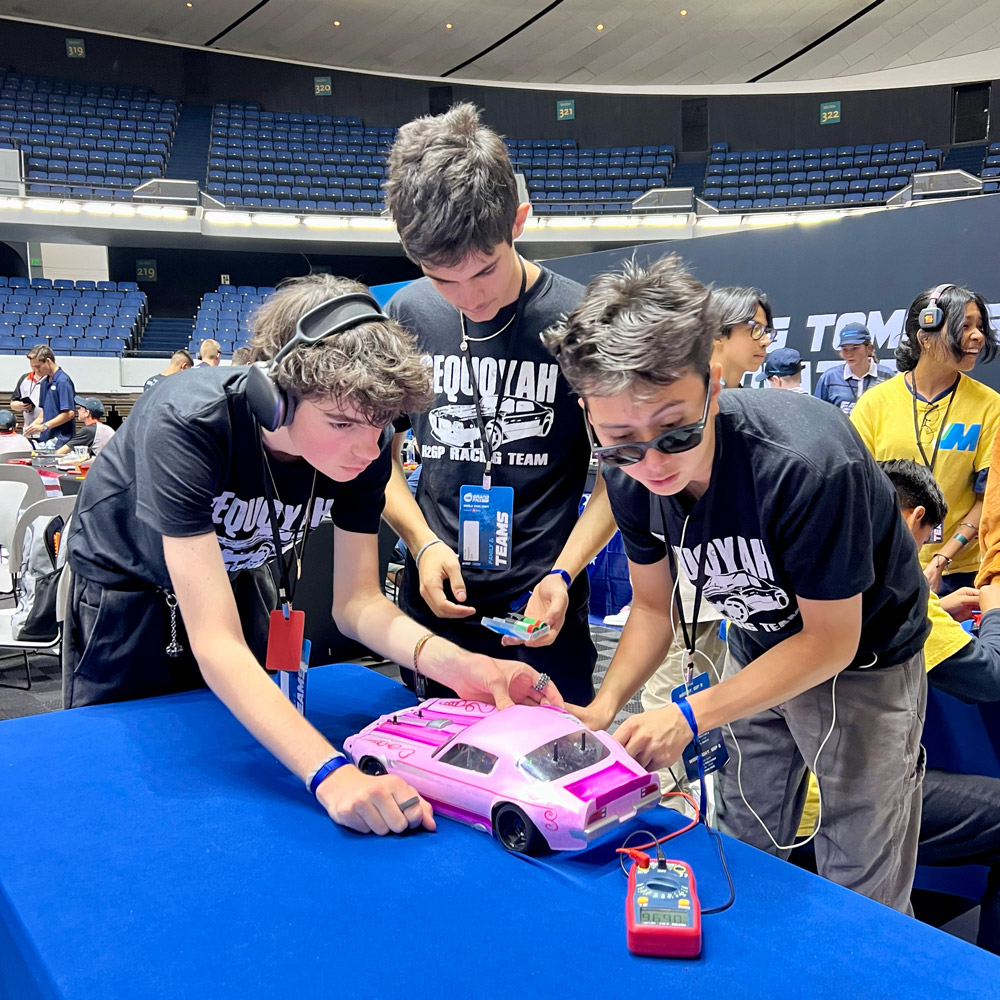
STEM at Sequoyah
The Amazing Race
It’s Spring Break, and Ross Chapel has been transformed into a racetrack. Two sleek stock cars—one black, one blue—tear down straightaways, navigate hairpin turns, and battle for dominance. Pit crews pull their model car aside, make modifications or repairs, and release their creations back onto the road. Timing and collaboration are everything, because the following day Sequoyah’s Hydrogen Grand Prix (H2GP) teams will compete to secure entry into the World Championships in Germany.
The Grand Prix is a worldwide competition where students build and race remote-controlled cars powered by hydrogen fuel cells. Each car is backed by drivers, engineers, and data analysts to ensure their car not only outpaces other racers, but outlasts them as well by carefully calibrating power usage. It’s an excellent way for young engineers and scientists to engage in today’s growing alternative fuel conversation through real-world problem solving.
“We have strong drivers and a refined strategy,” says Camilo Reynoso ‘25. “We have a pretty good shot at doing at least as well as we did last year.”
That’s putting it mildly; Sequoyah’s team entered the arena in a big way in 2024, securing first place at state championships and fourth in the world in just its first year. Inspiration for the team came from Director of Design and Fabrication Abraham Orozco, Kenya Gordon ‘26, and Harry Freeland ‘24. “I had five years’ experience running multiple teams at other schools,” says Abraham. “I thought it was a perfect fit for Sequoyah, and this year we expanded our program to two stock car teams—Dialed In and Track Dialed.”
With the help of donors, the team roster has expanded as well to over a dozen Sequoyah students and faculty working alongside one another. “I think when you are with your team, collaborating and passing on ideas, it makes it really easy to be successful,” says Kenya. “Abraham stays late every day to help us because he sees our passion on this project and wants us to succeed.”
“I serve as a knowledge base,” adds Abraham. “The students are designing and working on the cars, spending time after school practicing, and pushing innovation. They are in charge of the program and its success and how well the teams function. I just help them steer where to go in terms of logistics. And I think it really helps build strong connections.”
Dialed In is composed of veteran students who joined the H2GP program in its first year, while Track Dialed is crewed by newer members. (The team names are pulled from racing terms for peak performance and perfect track conditions, respectively.) Both teams have multiple drivers—some races can last up to six hours—in addition to maintenance crews and a data analyst, so collaboration is essential at all times.
Natalie Wray ‘27 serves as Track Dialed’s analyst. She’s trained alongside Dialed In’s Daisy Cano Ruiz ‘25 to learn the ropes and is also responsible for the design of her team’s hydrogen racer.
“I handle the data,” she says. “I keep track of our lap times to see where we went wrong or where we were going too slow. We also find the lap times of our top competitors to see if we’re on the same level or if we know we can beat them or not.”
Camilo, one of Dialed In’s mechanics, has found the process very rewarding. “It’s probably been the most transformative and realistic engineering experience I’ve had in my life,” he says. “It’s competitive, creative, and fun. If you enjoy engineering or you enjoy making art that you’ll see perform in functional ways, I would totally recommend H2GP.”
Last year’s winning car has been replaced with two new models. To lighten the racers, the students switched to narrower carbon-fiber chassis that lets them get more aggressive with their driving style without scarificing durability. The wiring has been completely redone, and the Sequoyah team installed custom-built computers that limit the fuel cell’s power output to create sustained, longer-lasting races. At the 2024 state championship, the team was able to complete 100 more laps than the second-place team. These upgrades could widen that gap even further.
“The majority of this year has been about refinement,” says Camilo. “That’s the way a lot of engineering projects work, especially when you already have the baseline knowledge to build what you got to build. The rest of it is just making sure it works the way you want it to work.”
Orion Thomas ‘27, one of Track Dialed’s drivers, appreciates how those refinements translate to the course itself. “I’ve enjoyed just being able to drive a lot. It’s a lot of focus you have to keep for an extended period of time, but if you can control it, it’s relatively relaxed if you handle your time right.”
Both teams ultimately exceeded expectations at state competition, outperforming last years’ lap count and earning Dialed In an invitation to the World Championships in August. Abraham hopes to bring members of both teams to Germany to race and celebrate the growth of H2GP at Sequoyah.
“I’m confident we will continue to strive to reach our potential and continue to value the principles that have made us as successful as we have been,” he says.
Above: Kenya Gordon, Avo Day, and Camilo Reynoso run diagnostics on last year’s H2GP car during a 2024 competition.
Top: Sequoyah’s H2GP team: Eurus Wang ‘27, Natalie Wray ‘27, Kenya Gordon ‘26, Aidan Byrne ‘26, Orion Thomas ‘27, Eric Yang ‘26, Andrew Fyke ‘26, Diego Del Toro ‘25, Camilo Reynoso ‘25, Ryan Asperger ‘25. Not pictured: Avo Day ‘25.
